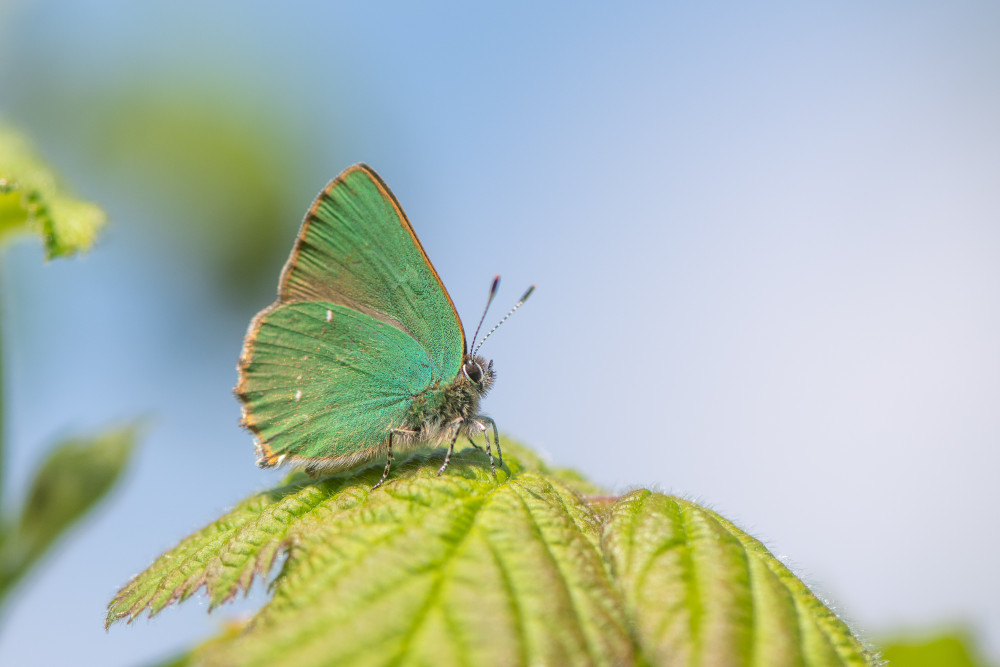Rare green butterfly is spotted at National Forest woodland near Measham in 'impressive' find
By Ashby Nub News Reporter 19th Apr 2025
By Ashby Nub News Reporter 19th Apr 2025

A rare Green Hairstreak butterfly has been recorded at Minorca Woods - part of the National Forest near Measham.
This is of the Forest's newest and most ambitious planting sites in and marks a promising start to this year's butterfly survey season.
The butterfly was spotted by Marion Farrell of Groundwork Five Counties, while on site with National Forest staff planning a new transect route for the UK Butterfly Monitoring Scheme (UKBMS).
The sighting came as a welcome surprise, occurring along the proposed route.
Dr Heather Gilbert, research and evidence manager at the National Forest, was out with the team and said: "We've had ecologists doing butterfly surveys at Minorca since 2021 and this is the first time green hairstreak has been spotted on site. We were all very excited to spot it."
Richard Jeffery, butterfly recorder for Leicestershire and Rutland Butterfly Conservation, described the find as "very impressive" in a message to the team.
He said: "This will undoubtedly be one of the highlights of the year,"
The green hairstreak is the UK's only native green butterfly. While relatively widespread in southern England and Wales, it is much rarer in the Midlands — making this discovery particularly significant.

With shimmering underwings and a fluttering, erratic flight, the green hairstreak is a small but distinctive species that prefers scrub, heathland, woodland edges, and grassland. Its need for warm, sheltered conditions makes regenerating sites like Minorca especially attractive.
Numbers of green hairstreaks have declined at monitored sites in recent years, and they often exist in small, scattered colonies. Its presence at Minorca suggests the site is already supporting valuable wildlife and highlights the early success of its habitat restoration.
Once dominated by coal mining, the 175-hectare site between Swepstone and Measham is undergoing a remarkable transformation.
More than 225,000 trees and shrubs have already been planted, creating a patchwork of native broadleaf woodland and conifer stands designed to capture carbon, support biodiversity, and improve soil health.
As the butterfly season gets underway, the Minorca sighting offers a hopeful glimpse of what restored landscapes in the National Forest can achieve.
Highlights of the site's transformation include:
- 53,000 trees planted at Minorca North, as part of a 75-year carbon capture pilot project.
- 60,000 native broadleaved trees at Minorca East, including field maple, alder, birch, aspen, and rowan—chosen to blend with existing hedgerows and farmland.
- Nearly 70,000 trees have been planted at Minorca West, including the creation of a new wetland habitat with open ponds to complement the existing nearby lake.
- New habitats such as wildflower meadows, wetland ponds, and hedgerow corridors to support pollinators, birds, and small mammals.
Stuart Dainton, head of land management and estate at the National Forest, said: "Minorca is a powerful example of ecological transformation.
"The regeneration of this land not only demonstrates the profound environmental benefits of restoration but also shows how ecosystems can recover and thrive when given the chance.
"People are connecting with nature in meaningful ways, valuing the environment, and seeing firsthand how restoration efforts can create sustainable, vibrant habitats for wildlife."
April marks the start of the field survey season, as butterflies, birds, and bees become more active with rising temperatures.
The new transect at Minorca will allow for regular, structured monitoring of butterfly populations and will contribute valuable data to national records on species distribution and abundance.
The National Forest is now recruiting volunteers to help monitor the new transect route throughout spring and summer. No previous experience is needed - just enthusiasm for nature and a willingness to learn.
"This is a brilliant opportunity for people to get involved in citizen science, spend time outdoors, and directly contribute to conservation efforts," said Dr Gilbert.
"We're especially excited to see what other species this site holds and how species might change as the habitat mature into the future."
CHECK OUT OUR Jobs Section HERE!
ashby vacancies updated hourly!
Click here to see more: ashby jobs
Share:















